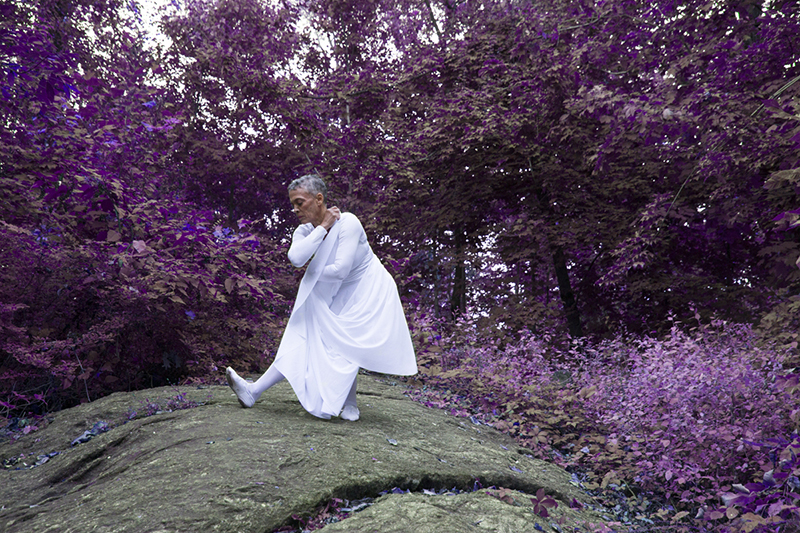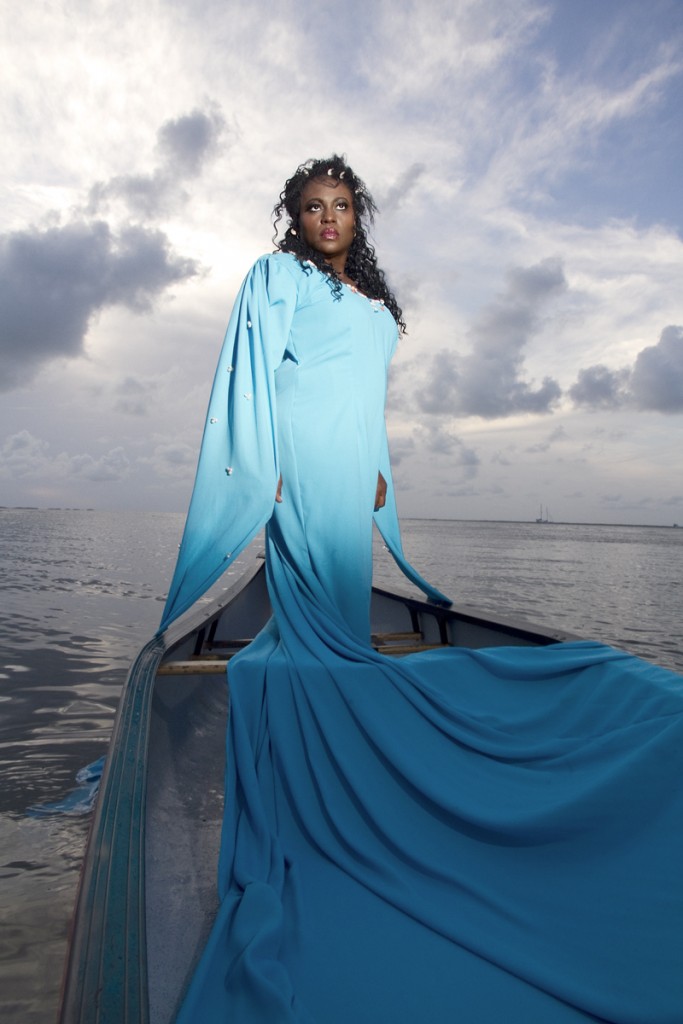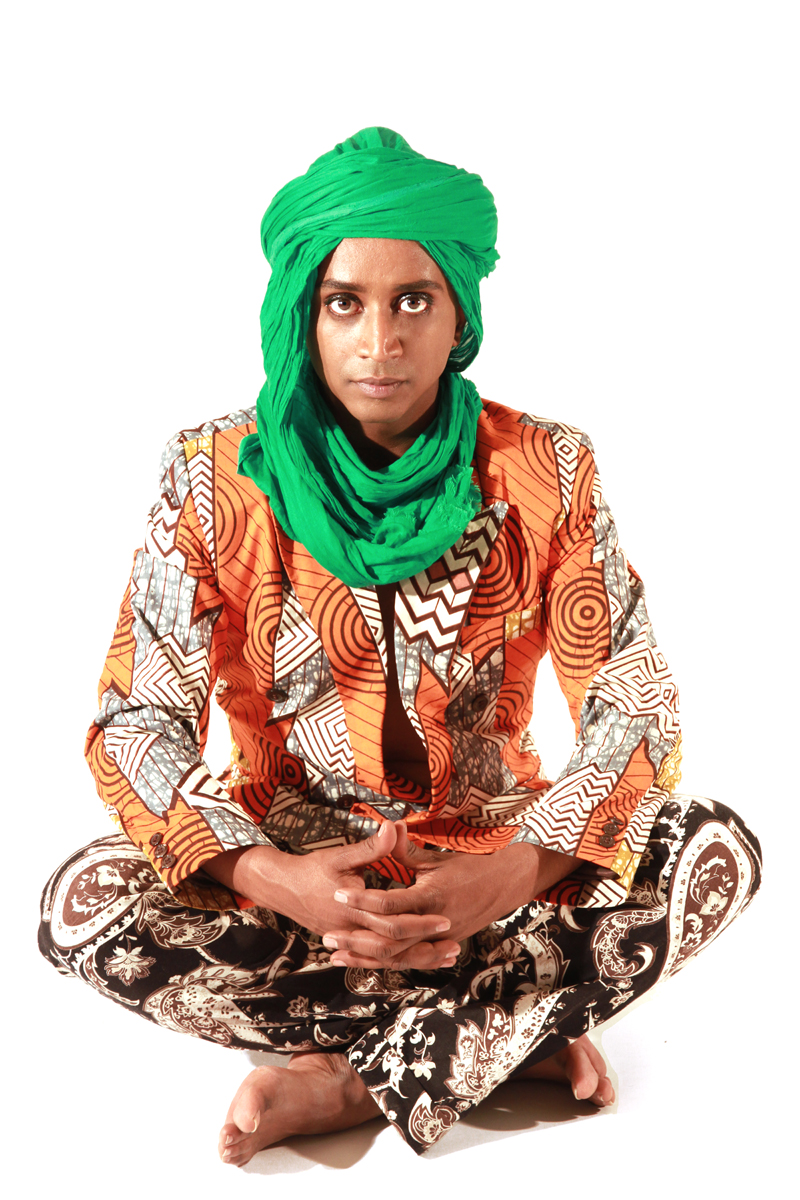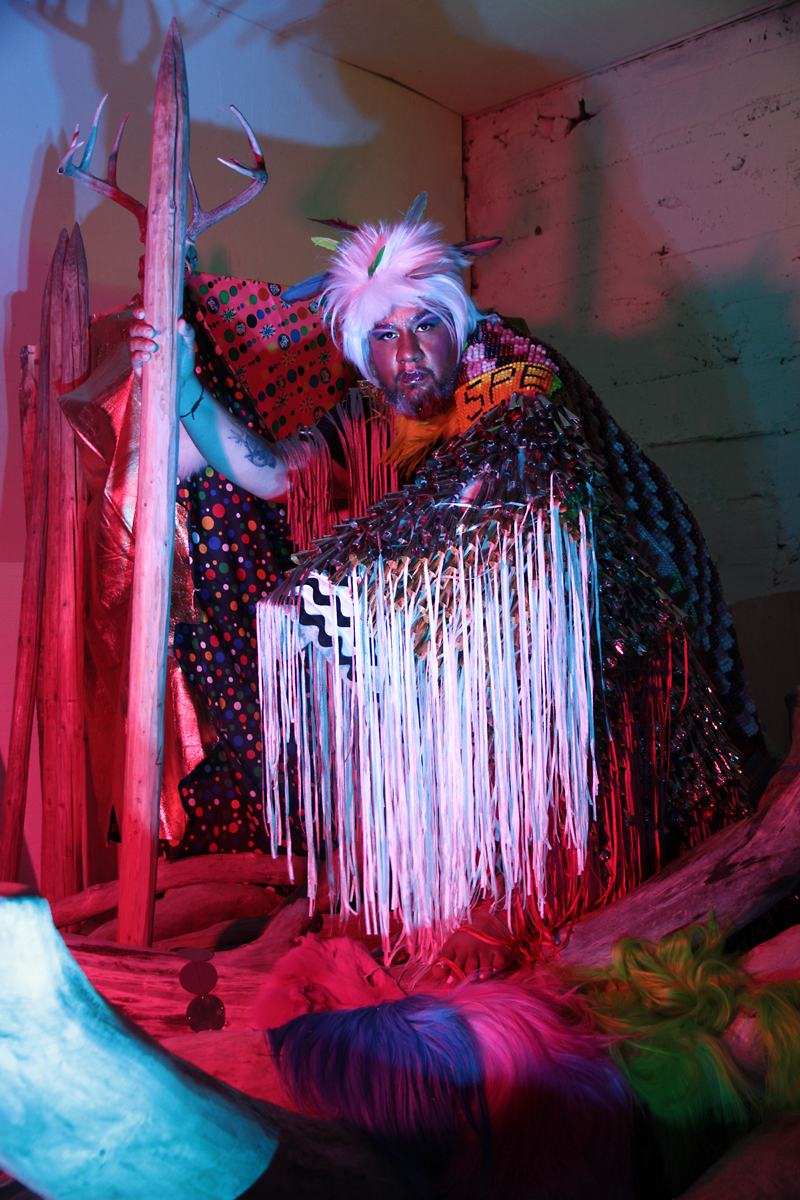Interview with Elia Alba
Elia Alba is a multidisciplinary artist whose practice revolves around building community. I caught up with Elia at a rooftop in mid-town Manhattan for drinks on a chilly fall day. (Featured image: The Spiritualist, 2014. Maren Hassinger in Inwood HIll Park, NY.)
Groana Melendez:
Can you tell me a little bit about your background?
Elia Alba:
My parents emigrated in the 1950s from the Dominican Republic. They grew up in the very same town, but actually “met” and fell in love here. I think it’s because the Dominican community was small. They weren’t in Washington Heights; it was the Upper West Side! My parents married in 1958. My grandmother arrived here first in the 1940s, and she lived in West Harlem.
Groana:
Before Trujillo?
Elia:
My grandmother came to New York during Trujillo. She was a very interesting person, very independent. Barely any education but traveled the world and learned how to sew and worked for milliners and coat designers and did all kinds of things. She worked ten months out of the year and traveled two. She did that for a long time.
Groana:
Your mom worked in the garment industry?
Elia:
Yes. Her last job, she was as an assistant designer, making the patterns for Betsey Johnson. Then she made knockoff dresses somewhere else.
Groana:
My mom used to work in the factories when they were here.
Did you grow up on the Upper West Side, or did you move around a lot?
Elia:
I don’t know what Dominican woman didn’t.
My mom used to brag about how we lived on the Upper West Side in a six-bedroom apartment with two fireplaces. It was $145 a month, and that was a lot back then so my mother would rent out rooms. My father hated that there were always other people in the house, so we had to move. We moved to 175th and Broadway, which was very Jewish. Then my father got tired of apartment living, and we moved to a house in the Bronx. I was 6, and my sister was 5, and we lived there until they decided that drugs were taking over New York (this was the late ‘70s). They packed it up and decided they were going to raise their daughters in the Dominican Republic, and yo, what a culture shock!
It was 1978, and I was 15, but it was 1943 over there! Girls did not wear shorts. Talk to your mama; she’ll tell you.
My parents decided to put me in this ritzy school that was really crazy. My first understanding of class was in the DR! I remember once, these girls invited me to go bike riding in the park. It was heavily chaperoned. They came to get me, and I had on a tank top with spaghetti straps and shorts. When they arrived and saw me, they said, “We can’t go out with you like that. You look like a hooker.” I was like, “What’s a hooker?” I was 15 years old! So I had to go back in and wear a long-sleeved shirt and jeans. It was July in the DR. It was the worst bike ride ever. I don’t think my mother was aware how lame the DR was at that time. It was my introduction into how things functioned there.
Groana:
How long were you there?
Elia:
I was there a few years, until 1981, but it was my core years. I really feel it formed me in some kind of wacky way. It made me all uptight about things.
When I got to the States, it was just different. I was open-minded but very conflicted. I learned a lot about class and color. I always felt ugly in the DR. I had to press my hair too. They made me put chemicals in it.
Groana:
I begged to have my hair relaxed at nine years old.
Elia:
Of course! We all did, and our parents didn’t help us, making us feel uncomfortable about looking the way we did because they felt uncomfortable. I’m not even angry with them, but it’s interesting because I think my family and those that I was around pushed the straight-hair thing. It was actually white folks that would tell me, “Oh my god, your hair’s so beautiful. Why are you doing that?” It was kind of weird. Like, “What? Who are you with your straight hair talking like that? Get out of here.”
Groana:
Did you always have to balance a day job with your artist practice?
Elia:
All the time. Is the next question, “How do you do that?” or “Why do you do that?”
Groana:
Are you happy with your day job?
Elia:
I don’t hate my day job. I actually like going to work, because I’m very independent with how I want to do things. I don’t want to rely on grants. I don’t like writing applications. I do have to say that there are times when I wish I lived more of an “art life,” especially when it comes to residencies. It would be nice to just get up and go, but I would be stressed out about money.
Groana:
Right. That’s where I’m at right now.
Elia:
I also had a kid, and I just felt like, “No, I can’t put him through that lifestyle. I’m just not going to do that.” I know people have done it, but that’s just not my thing.
I want to be able to do work and just do my art practice on my own terms and have the money to do it. It’s a choice. Just like you make that lifestyle choice to be that artist that wants to live grant to grant. No one should criticize your choice for working. I did know I didn’t want to work in an art institution. That would zap me. I didn’t want to give them my creativity in that way. I think I’m creative in my job, within its limitations, but it doesn’t zap me of my creativity. It doesn’t tap that source.
Groana:
How did Supper Club start?
Elia:
The Supper Club started in 2012, so it’s been going for a minute. I am having a solo show at The 8th Floor Gallery in fall 2017, where we will show all 60 portraits. The 8th Floor is an exhibition and events space located in Chelsea. It was established in 2010 by The Shelley & Donald Rubin Foundation. The foundation is dedicated to promoting cultural and philanthropic initiatives. They have been hosting and funding the Supper Club since 2015, so I am really excited to be presenting the project there.
A lot of my practice is about bringing together different kinds of communities, and I wanted to make a book that was about artists of color, but not necessarily black and Latino. It has Southeast Asian folks, Arab folks some mixed-up folks because I feel like that’s really where the color conversation should be residing.
Initially, I was just going to make portraits, and I asked my friends. Not everyone in the book is my close friend, but rather people I’ve known along the way. Then I started thinking about how I wanted to give these artists a voice because it’s not enough just to take the picture and write a description. Recess Art came on board, and we began talking about hosting dinners, having conversations, and recording them. Initially, it was just going to be three dinners with three groups, of the artists that I was photographing.
That first dinner was intense. It brought up important issues for folks of color that people don’t like talking about but can’t deny. For example, either you’re not black enough, or you’re not Latino enough, or you can’t be part of this conversation because you’re Southeast Asian. All these different positions came up. It wasn’t the intention of the first dinner. I just wanted to let people talk. I didn’t say anything or give them any prompts, the way I do now.
Let me backtrack. The prompt for the first dinner was when I asked Wanda Ortiz to come in as her performance character “Chuleta” and be a provocateur and poke people to talk. She was the “host” for those first three dinners. After the third dinner, I realized that I wanted to keep doing it. At first, as I said, it was only the artists I was scheduled to photograph, which was 50 at the time. I’m up to 60, and that’s it.
Groana:
You have 60 portraits already!? That’s insane!
Elia:
It is insane. I remember when I was talking to our buddy LaToya (Ruby Frazier), and I was like, “I want to do one hundred!” She says, “Elia, you’re crazy! You should do twenty or twenty-five.” I said, “Twenty-five is not enough. That is definitely not a conversation.”
Groana:
It’s like a spotlight.
Elia:
And then who are the rest that you don’t see?
Fast forward. Recess and I started the dinners. We didn’t host another big one. We started doing smaller dinners with groups of five and six people, and we ordered takeout. Now the dinners take place at The 8th Floor. Sara Reisman, the artistic director, wanted to work with me. She’ll tell you, “I wanted to bring this to Rubin’s because I wanted to sit at the dinner table, and I knew that was the only way I was going to do that!” Because I kept it only non-white folks for a while. I was adamant about that. Although I did loosen it up in 2014 and allowed some good friends to join because of the nature of the work they were doing. I felt they could sit at the table. They were quiet, which was interesting.
Groana:
Because a lot of times, that’s the problem, right? Just listen. We just need you to listen. Don’t try to tell us what’s right or what’s wrong.
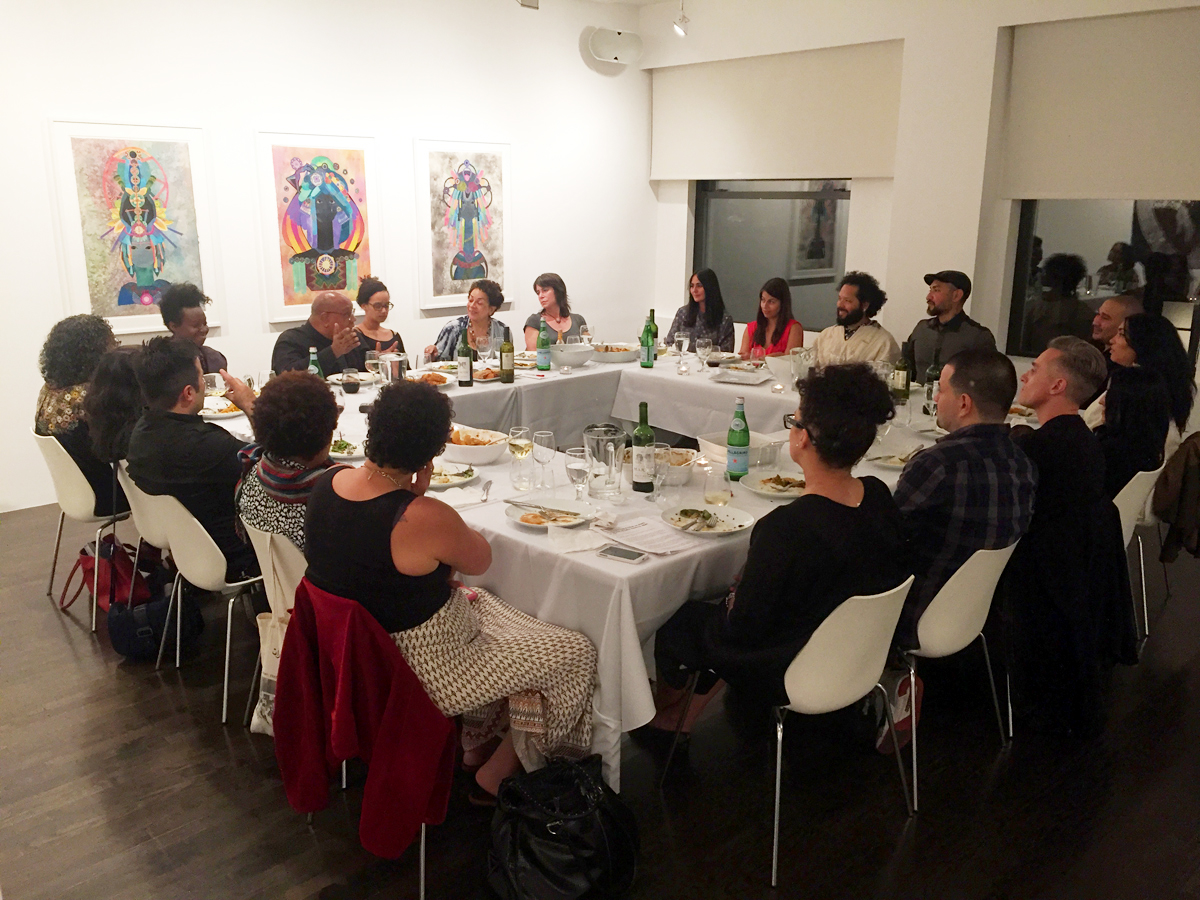
Dinner on Racial Subjugation in Latin America, at The 8th Floor, The Shelley and Donald Rubin Foundation, October 10, 2015.
Elia:
I think the first white person I had at the table was Maris Curran, a filmmaker who had just finished working on a project called Five Nights in Maine, which deals with an interracial relationship. The film was very powerful because it dealt with this interaction between a black male whose wife dies and he goes to visit his mother-in-law. The film revolves around that visit.
So that’s how The Supper Club started. I was really lucky to have Recess jump start this project. I always say this over and over; Recess is about ideas, which is very unlike a lot of arts organizations, where you have to submit a full-blown concept. Recess just liked the idea so much that they funded the first dinners. They funded the first photographs. That really jump-started the project. It’s taken so long because I had to move on from them. Then I ran out of money. I did a Kickstarter. I started to take more pictures, and then I ran out of money again.
The Rubin Foundation came into the picture in 2015. There was, however, an important shift that came in late 2014. While I was having these small dinners, I realized I wanted to host big dinners again, but this time I wanted to cook. At this time I was funding the project on my own, and with the help of my friend and curator Rocio Aranda and her husband James Congregane, they granted me permission to use the recreation room, which had a kitchen, in their building to host these large dinners. I noticed that once I did the cooking, it shifted the dynamic to how people interacted. Now we’re talking about an exchange. Even when you’re buying dinner for people, it’s not the same. I would cook (and still do) comfort-type foods. Like Saya (Woolfalk) said, “It’s like coming home for Thanksgiving Dinner!” That’s the feeling.
That really shifted it for me. It really was about looking at this group of color collectively. I do feel that this is a conversation that no one wants to have. Or they do want to have it, but not really, because it becomes you’re against something when you’re not, or you don’t understand when you do. That’s the complexity, I think. A lot of it having to be Caribbean, because we were raised that way all the time. I think when you look at my work, it really is about addressing the complexity of race and complexity of identity, which people want to put in a fixed place, but it’s not. I don’t even believe people are fully one race or the other, even if they look it. There’s always other stuff going on. That’s a lot of what drives this, and it drives everything. I was shocked when some people agreed to sit for me. I like my portraits; some of them are fun, and some of them are serious, depending on the artist. Some people let me go to town with them.
Groana:
I really like Juana Valdes’ portrait. It’s gorgeous.
Elia:
Juana was like la diosa Olokun in the middle of the ocean. Juana’s portrait is crazy. I can’t wait until you see the others. The pictures reference other artworks or time periods. The Supper Club has all these little stories about how I photograph people.
I know people are different. I know certain histories that we bring into this country are different, whether it is forced or not, but there’s also similarity. Southeast Asians were dominated by the British for a century. They have that in their history! Folks of color have the imperialist oppression in their history. Why do we want to focus on dividing? I want to have that conversation. However, when I have these dinners, there’s always tension.
I always pray for a kumbaya moment. I did have one during the last dinner. I invite hosts now, and my last host was Edwin Ramoran and his question was, “How do you define sanctuary?” It was a table full of queer folks: Filipino, Latino, African-American. In the end, everyone went from sanctuary to safety, and about feeling safe as a person of color. Nobody felt safe at that table. That said something. It was just a beautiful moment. There was a teeny moment of tension, like a second, but then it dissipated.
In my 20 plus dinners, I’ve had maybe one or two where that kind of moment lasted. Everyone just felt it. But even at the first dinner, the last person you heard was Simone Leigh saying, “That was intense, but it was good.” It’s about these conversations that in my opinion have to happen. I think as black Latinos, this is a thing we have to go through because people want you to pick sides. If you pick the Latino side, then you’re saying you’re not black, which is not true! Ever!
Groana:
Today I realized that you actually record the dinners. I just imagine walking into that situation and already being on guard, knowing that it is being recorded.
Elia:
People were a little bit guarded, but I always feel a little alcohol doesn’t hurt none.
I always tell people, “Keep the conversation real.” Whatever is out of pocket will not be published, sometimes to keep the conversation going, you might have to tell a little story or two. You might have to be a little critical, or you might have to badmouth somebody. It’s not about gossiping. You need those kinds of fillers and those kinds of scenarios or points within the conversation so people can relax. Some people do come to dinner very structured. They’re like, “No, I’m not saying anything.” I’ve gotten to the point now where I feel, “If you ain’t going to talk, you can’t come.” I used to say, “You can sit down and just observe,” but no—that time came, but that’s over.
I provide prompts with questions, so people can start thinking, but the conversation might go in another direction. I might say, “What is sanctuary?” We could start talking about disco balls, and I don’t flip that conversation. I have to let it organically evolve, because if I start to shift-shape it, it will then be a talk at a university or something, and that’s not what it is. People are fine with it now. Some people get a little crazy; I’ve had issues.
Groana:
What kind of issues? Tension between people? Because it sounds like mini therapy.
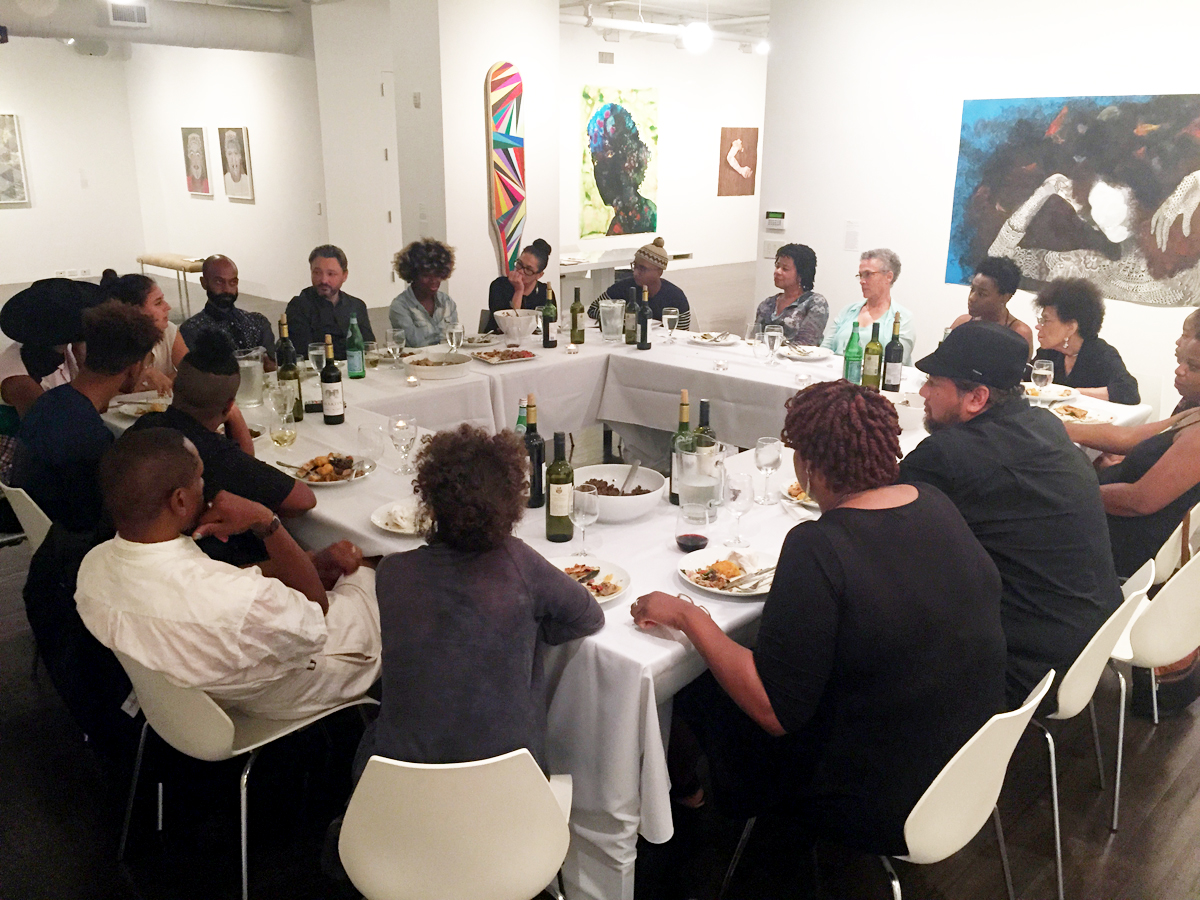
Dinner on Global Blackness and Transnational Identities at The 8th Floor, The Shelley & Donald Rubin Foundation, August 14, 2015.
Elia:
“No, I didn’t say that.” I’m like, “Yeah, you did.” “No, I didn’t.” Then I send them the transcript and they say, “Oh, but you can’t print that.” But people are getting a little better. There was a moment where some artists felt that if you had some political opinion about anything, somehow a curator or a collector wouldn’t collect you. But there are a lot of political artists that are collected, and they say anything. They say what they’re going to say. A curator? They’re doing a show on something, and you’re doing work like that, and they like you, and you have a reputation, and you have awards to back you up? They’re not going to not work with you.
But we are fearful as artists, so that was the initial challenge of this. Yeah, it is therapeutic. I think I wanted it to be therapeutic for me. I think it always starts from the place of the self, right?
Sometimes it makes me sad. Sometimes I walk out of there sad. Sometimes I walk out of there so angry. It really depends, you know?
Groana:
How do you bring the idea of The Supper Club to a wider group?
Elia:
Here’s the thing. I discovered that in order to have an intimate conversation, we could have 20, 25 people tops. Twenty-five is a lot. Twenty, where everyone’s participating, is closer knit. We had one dinner that accidentally almost had 35 people. That does not work. It’s not a dinner; it’s a conference. You have to think of dinner at your mom’s house. My mom would serve 20 people. I don’t know what it is about that number, but that’s the number.
Late in 2015 and early 2016, I did two dinners in Washington DC, sponsored and hosted by Jessica Stafford Davis’ Agora Culture. That brought together an amazing crowd from DC and I did manage to get a couple of artists in the book to go to DC.
Groana:
But how does a kid in the Midwest—in the middle of “nowhere” right now—create a similar space?
Elia:
You start with your friends. I think people need to start with their own communities. I think we have this going on all the time; we just don’t think about it. My friend Clifford Owens, who was at one of the dinners in DC, reminded me of this. He said to the group at the table, “You know Elia has been doing these dinners since 2004 at her house. She’d make food, and we’d sit down, and we talk about art, we talk about race, we talk about politics. It just wasn’t recorded.” If I look back, that’s what my mother used to do. Make food and have her friends over, and they would hash out sports, politics, art, pop culture. This is no different.
You start with your community first, and you challenge your community. You challenge them with challenging questions. I organized a dinner in December 2014 that was the year that Mike Brown and Eric Gardner were killed. I wasn’t sure what we were going to talk about, until the night before the dinner. I emailed everyone and told them, “We’re going to talk about these killings because I don’t know how we can not talk about anything else at this moment.” Everybody came fired up.
One artist said, “Right around the time of Art Basel, everyone was up in arms about Trayvon Martin, but they still showed up to Miami. We went to Florida anyway.” All that came out. “What are the post-black artists thinking now? Take three seats back.” Things like that were coming up. Then there was another artist who said, “Fuck race! The planet is dying, and it’s not going to fucking matter!” Then Shaun Leonardo said, “I’ll worry about the planet when I don’t have to worry about a gun being put to my head.” That dinner had Coco Fusco, Lorraine O’Grady, Maren Hassinger, Kalup Lindsey, Arnaldo Morales, Clifford Owens to name a few. It was the dinner my filmmaker friend, Maris Curran attended.
We had this writer, Juan Thompson, who was reporting from St. Louis. He was studying to be an attorney and then switched to become a journalist on race issues. We had a curator from The Whitney. It was incredible. There was no kumbaya moment, but collectively everybody was upset with what was going down. My question was, what about Rodney King? That was in the early 1990s. What happened to those fools who beat him up? They’re walking around free.
Groana:
How long do you think The Supper Club will go on?
Elia:
Right now, I’m doing a residency at Lafayette College, where I am printing the portraits for the exhibit. I am also working on the book itself, and I have to start doing some writing for it. We are planning additional dinners too. The Rubin Foundation will continue to sponsor and host dinners, and I have been in talks with another arts organization to do the dinners nationally. How long will it go? It is unclear to me but I do see it going on for a while.
Groana:
What was your major in undergrad?
Elia:
I attended Hunter College and completed a special honors curriculum for interdisciplinary studies, and minored in studio art. I was a terrible painter! I gave my brushes away. I thought getting expensive brushes would make me a good painter. It did not. When you’re not good at something, you need to let it go. Because your creativity isn’t just around one thing. I know when I see a good painting, and I know when it’s not great too. God bless all the people that can paint. Painting is hard. Good painting is really hard. Not everybody can do it.
During school, I got a full-time job at L’Oreal. I was working with the sales department, with PR planning all the meetings and parties. That’s still going on! So I thought I was going to go into PR. Then I was like, “No, I want to be creative.” So when I graduated, I said to my boss, “I really want to get into the art department.” They had me do something for a Paloma Picasso’s fragrance called Minotaur. I designed the cover of the box and packaging for the spring collection in ‘94 or ‘95. By the way, nothing was on a computer. I did it all by hand!
I had so much fun doing it, and at that point, I discovered I was good with materials. I told myself, that’s where I need to be heading. I quit my job. I was about to turn 33, Jesus Christ’s age, and I enrolled in the Arts Students League because I didn’t know where else to go. I applied to Hunter for an MFA, and they liked the work I presented, but when I sat in front of the committee, I didn’t know what I was talking about. They said, “You should know what you’re coming in here for. You need to know what you’re talking about with your work.” I said, “If I need to know, that defeats the purpose of getting an MFA.” I was being argumentative, which was probably not a good thing. Of course, I didn’t get in.
I get it now; you should have somewhat of an understanding of what you’re doing. Not a full-blown explanation, but something. I applied again, and I didn’t get in a second time, but I did get into the Studio Museum in Harlem Residency Program, which was cool. I was working a lot with materials, doing abstraction work with a lot of sand and wood and paper, but then I got pregnant. I’m allergic to all that stuff, so I was like, “I can’t pop pills and be pregnant.” I literally changed my game. I went from working with materials like that to working with fabric. At the same time, I changed from abstraction to figurative. I think that’s how art functions. I don’t think 90 percent of the time it’s intentional, or that you’re totally aware, “I’m going to do this, and it’s going to be that…” You just evolve.
